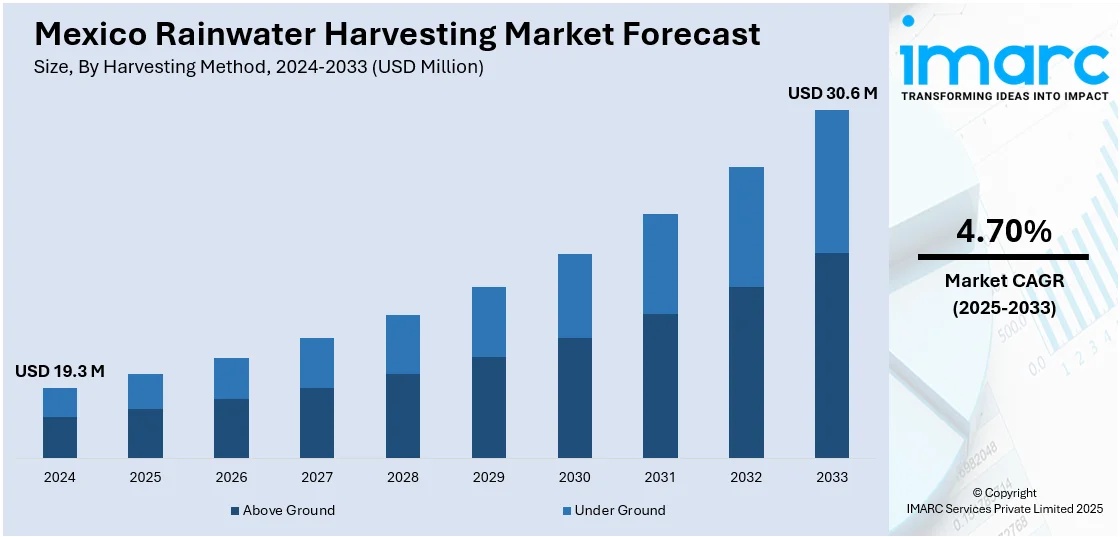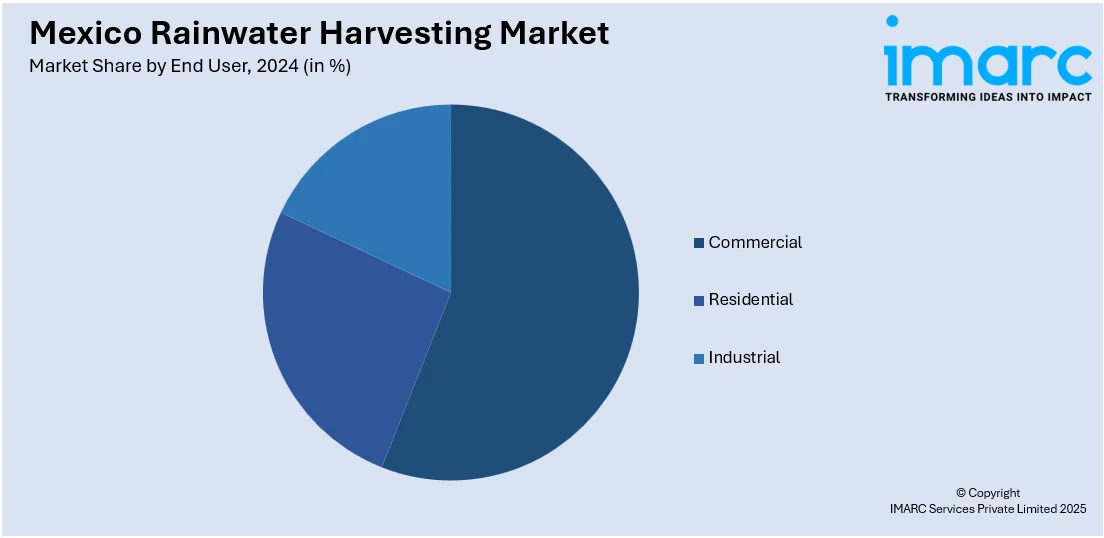
Mexico Rainwater Harvesting Market Size, Share, Trends and Forecast by Harvesting Method, End User, and Region, 2025-2033
Mexico Rainwater Harvesting Market Overview:
The Mexico rainwater harvesting market size reached USD 19.3 Million in 2024. Looking forward, IMARC Group expects the market to reach USD 30.6 Million by 2033, exhibiting a growth rate (CAGR) of 4.70% during 2025-2033. Economies of increasing water scarcity, support from governments through subsidies and policies, emerging environmental consciousness, and the pressure for sustainable management options for water drive the momentum. Urban growth and agricultural pressures additionally fuel the installation of rainwater harvesting systems in Mexico.
|
Report Attribute
|
Key Statistics
|
|---|---|
|
Base Year
|
2024 |
|
Forecast Years
|
2025-2033
|
|
Historical Years
|
2019-2024
|
| Market Size in 2024 | USD 19.3 Million |
| Market Forecast in 2033 | USD 30.6 Million |
| Market Growth Rate 2025-2033 | 4.70% |
Mexico Rainwater Harvesting Market Trends:
Government Initiatives and Policies
Mexico’s government plays a pivotal role in promoting rainwater harvesting through comprehensive regulations, financial incentives, and educational campaigns. In 2024, Mexico City’s Congress unanimously made the Rainwater Harvesting program constitutional. The reform promotes rainwater harvesting through administrative, financial, and technological support, focusing on underserved areas, schools, and low-income regions. It mandates rainwater systems in new buildings, wastewater treatment, water conservation awareness, and infrastructure designed to recharge groundwater, aiming to improve water access, especially in water-scarce areas. Urban areas, particularly those facing severe water stress, benefit from these initiatives, as they encourage both residential and commercial sectors to invest in sustainable water management solutions. Furthermore, partnerships between public institutions and private enterprises have strengthened the implementation of rainwater harvesting projects. These efforts align with Mexico’s broader environmental goals, aiming to enhance water security, reduce dependency on traditional water sources, and promote sustainable development across the country. For instance, in March 2024, Operation Blessing implemented rainwater harvesting systems in remote indigenous communities in Mexico to address severe water scarcity and contamination issues. The new systems can collect, store, and purify up to 1,300 gallons of water per household, significantly reducing health risks. Additionally, the initiative includes water management and conservation training to ensure long-term sustainability, empowering communities to maintain clean water access even during dry seasons.

Technological Advancements in Water Management
The Mexican rainwater harvesting market is experiencing transformative growth driven by advancements in water management technologies. Innovations in filtration systems, including multi-stage filters and UV purification, ensure the collection of high-quality water suitable for diverse applications. Additionally, smart storage solutions with automated controls, such as IoT-enabled sensors, monitor water levels, detect contamination, and optimize water usage efficiency. These technologies not only enhance the sustainability of rainwater harvesting systems but also improve their adaptability to various environments, including urban, industrial, and agricultural settings. The integration of real-time data analytics allows users to track water consumption patterns, predict maintenance needs, and reduce operational costs. For instance, the "Rainwater Quality Monitoring and Harvesting Technology Evaluation" project, conducted by Metropolitan Autonomous University (Mexico) and Florida International University (USA) in March 2024, assesses the adoption and abandonment of Rainwater Collection Systems (SCALL) in Mexico City. It investigates technical, economic, social, and cultural factors, including system maintenance, operation, and disinfection. The study also explores gender differences in system adoption and maintenance to inform public policy and support investments in alternative water sources throughout Mexico.
Mexico Rainwater Harvesting Market Segmentation:
IMARC Group provides an analysis of the key trends in each segment of the market, along with forecasts at the country and regional levels for 2025-2033. Our report has categorized the market based on harvesting method and end user.
Harvesting Method Insights:
- Above Ground
- Under Ground
The report has provided a detailed breakup and analysis of the market based on the harvesting method. This includes above ground and under ground.
End User Insights:

- Commercial
- Residential
- Industrial
A detailed breakup and analysis of the market based on the end user have also been provided in the report. This includes commercial, residential, and industrial.
Regional Insights:
- Northern Mexico
- Central Mexico
- Southern Mexico
- Others
The report has also provided a comprehensive analysis of all the major regional markets, which include Northern Mexico, Central Mexico, and Southern Mexico, and others.
Competitive Landscape:
The market research report has also provided a comprehensive analysis of the competitive landscape. Competitive analysis such as market structure, key player positioning, top winning strategies, competitive dashboard, and company evaluation quadrant has been covered in the report. Also, detailed profiles of all major companies have been provided.
Mexico Rainwater Harvesting Market News:
- In September 2024, Arca Continental, one of the largest Coca-Cola bottlers globally, partnered with the Coca-Cola Foundation Mexico to invest over 40 million pesos in 190 new rainwater harvesting systems for schools across Mexico. This initiative, part of the "Escuelas con Agua" program, aims to provide clean water access and promote responsible water usage among students.
- In January 2025, Grupo Bimbo expanded its "Escuelas de Lluvia" (Schools of Rain) program, part of its Buen Vecino initiative, to combat water scarcity in Mexico. Launched in collaboration with Isla Urbana and Agua Capital, the program installs rainwater harvesting systems in schools, coupled with water-saving handwashing stations and conservation workshops. The initiative includes a two-year follow-up for sustainability, training school communities on system maintenance, reflecting Grupo Bimbo's commitment to environmental preservation and community engagement.
- In March 2025, Diageo Mexico enhanced its water sustainability efforts through investments in conservation projects aligned with its global Society 2030: Spirit of Progress strategy. The company allocated MX$100 million (USD 4.9 Million) for initiatives in Jalisco, including rainwater harvesting, wastewater treatment, and watershed restoration. Key projects include the Ocotlán Wastewater Treatment Plant and Charco Bendito watershed restoration. Diageo aims to reduce water consumption by 40% by 2030 and replenish more water than it uses in its distilleries by 2026.
Mexico Rainwater Harvesting Market Report Coverage:
| Report Features | Details |
|---|---|
| Base Year of the Analysis | 2024 |
| Historical Period | 2019-2024 |
| Forecast Period | 2025-2033 |
| Units | Million USD |
| Scope of the Report | Exploration of Historical Trends and Market Outlook, Industry Catalysts and Challenges, Segment-Wise Historical and Future Market Assessment:
|
| Harvesting Methods Covered | Above Ground, Under Ground |
| End Users Covered | Commercial, Residential, Industrial |
| Regions Covered | Northern Mexico, Central Mexico, Southern Mexico, Others |
| Customization Scope | 10% Free Customization |
| Post-Sale Analyst Support | 10-12 Weeks |
| Delivery Format | PDF and Excel through Email (We can also provide the editable version of the report in PPT/Word format on special request) |
Key Questions Answered in This Report:
- How has the Mexico rainwater harvesting market performed so far and how will it perform in the coming years?
- What is the breakup of the Mexico rainwater harvesting market on the basis of harvesting method?
- What is the breakup of the Mexico rainwater harvesting market on the basis of end user?
- What are the various stages in the value chain of the Mexico rainwater harvesting market?
- What are the key driving factors and challenges in the Mexico rainwater harvesting market?
- What is the structure of the Mexico rainwater harvesting market and who are the key players?
- What is the degree of competition in the Mexico rainwater harvesting market?
Key Benefits for Stakeholders:
- IMARC’s industry report offers a comprehensive quantitative analysis of various market segments, historical and current market trends, market forecasts, and dynamics of the Mexico rainwater harvesting market from 2019-2033.
- The research report provides the latest information on the market drivers, challenges, and opportunities in the Mexico rainwater harvesting market.
- Porter's five forces analysis assist stakeholders in assessing the impact of new entrants, competitive rivalry, supplier power, buyer power, and the threat of substitution. It helps stakeholders to analyze the level of competition within the Mexico rainwater harvesting industry and its attractiveness.
- Competitive landscape allows stakeholders to understand their competitive environment and provides an insight into the current positions of key players in the market.
Need more help?
- Speak to our experienced analysts for insights on the current market scenarios.
- Include additional segments and countries to customize the report as per your requirement.
- Gain an unparalleled competitive advantage in your domain by understanding how to utilize the report and positively impacting your operations and revenue.
- For further assistance, please connect with our analysts.
 Request Customization
Request Customization
 Speak to an Analyst
Speak to an Analyst
 Request Brochure
Request Brochure
 Inquire Before Buying
Inquire Before Buying




.webp)




.webp)












